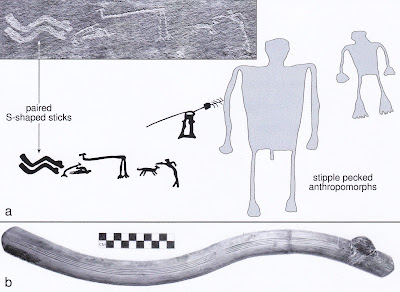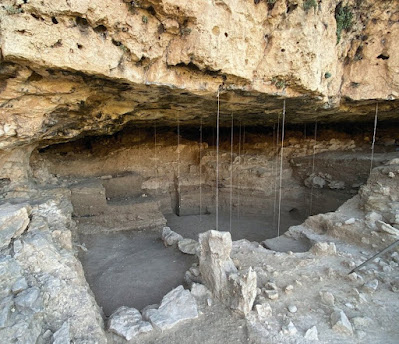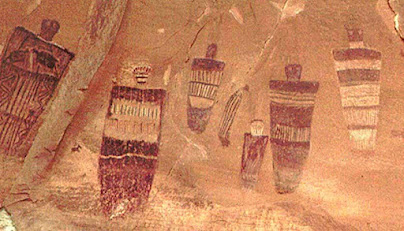Virtually
any sinuous form by itself in rock art has been identified either as a serpent,
or a ‘rabbit stick’. These were once often referred to as ‘boomerangs’ as well.
There is another possibility, however, that is not mentioned as often – these
forms may represent fending sticks. These date back to the period before the
bow and arrow when the common projectile weapon system was the atlatl and dart.
Warriors could carry fending sticks to deflect the darts from an atlatl. With
the right timing the dart could be deflected to the side with a sweeping
movement of the fending stick held in front of you. This has actually been
demonstrated as an experimental archeology project by some fearless, or crazy,
graduate students.
In the early days of archeology in the American southwest these “S-shaped” grooved sticks were usually identified as rabbit sticks or boomerangs, assuming that they were meant as a throwing weapon for small game hunting analogous to Australian aboriginal non-returning boomerangs. “Curved wooden throwing sticks, or “rabbit sticks,” also could be hurled at small game. In concept, they are not unlike the Australian boomerang, although rabbit sticks do not return to the sender. Also, known as fending sticks, the curved sticks may been used as weapons, for warding off blows in battle.” (Texas Archaeological Research Laboratory)
When found
in rock art, however, these shapes were once almost universally identified as
snake images. I would argue, however, that an image intended to be a serpent
would include some serpent-like details; a head, forked tongue or in the
American southwest rattlesnake rattles.
More
recently the use of these items as fending sticks has gained some purchase. These
fending sticks can indeed be taken as evidence of warfare. As Stephen A LeBlanc
(1999) explained “There are
Basketmaker rock art depictions
of men holding trophy skins, there was a special form
of basket used only to
dry and stretch scalps, and fending sticks are commonly recovered along with atlatls. This last item may need clarification. During
the earliest times in the Southwest, the bow and arrow were not present, and the atlatl
was used to throw
small spears or darts.
With these atlatls, curved sticks with a thong that
was wrapped around
the user's wrist
are often found. The best explanation for these sticks is
that were used to fend off darts thrown
by atlatls. That is, they served as a kind of
shield-thus, their
sole function would
have been warfare. If frequency and standardization of fending sticks
are any measure,
warfare using atlatls
was also quite common.” (LeBlanc 1999:3) In other words, the
argument is that their association with images of atlatls suggests a
relationship, and indicates their use as fending sticks.
An explanation from the Maxwell Museum in Albuquerque gives a clear description, and suggests the relationship between fending sticks and rabbit sticks. ”The prehistoric sticks come in two basic shapes: the S-shaped version shown above, and sticks shaped like an open C. It's possible that the S-shaped sticks are older, and functioned primarily to defend the user against incoming atlatl darts. Such darts travel slowly enough that with practice, it's possible to deflect them as they approach—at least that's the theory. The S-shaped sticks are our best candidates for "fending sticks." Fending sticks became obsolete once the bow and arrow was adopted in the Southwest, about 1,400 years ago. Arrows travel too quickly to be batted to one side by the intended target. Instead, the region's warriors began using shields. Under this telling of events, the loss of the "fending" function led to the use of shorter, C-shaped sticks used primarily for throwing—the modern Pueblo "rabbit stick." (Maxwell Museum) Of course, a thrown stick can still be thought of as a weapon as well.
Phillip R. Geib has also led in the area of study into the use of fending sticks in the American southwest and rock art. “A defender can knock aside atlatl darts from close range with these sticks. Some tribes in South America perform a similar feat in a duel-like context and Diego de Landa may have observed an analogous ritual in the 1500s among the Yucatec Maya. The fending hypothesis is most logical in a duel. Many of the analyzed prehistoric sticks come from a known Puebloan war god shrine in central New Mexico, where an informant identified one as symbol of membership in a warrior society. In addition to prowess as a man killer, war society membership in the distant past might have involved atlatl duels where dart defense with a stick displayed great skill and courage. Basketmakers may have considered S-shaped sticks as an ancient symbol of warrior status.” (Geib 2016) This is very strong evidence of the use of these bent sticks in personal defense, and a reasonable hypothesis for their being recorded on the rocks, a record of a warrior’s personal status.
Geib backed up his
researches into the use of fending sticks in the American southwest with
related and contemporary examples from South America. “Deflecting atlatl darts with a short stick might seem absurd or
illogical, yet certain tribes in South America still conduct duel-like atlatl
fights that involve dart deflection for defense. - - Warriors from opposing villages are paired
to face each other; one is on offense first while the other is on defense, then
the roles switch. The group with the greatest number of ‘hits’ is judged the
winner. - - Dart defense in this South American example is achieved with a more
substantial obstacle than a FCS (flat curved stick). Still, it shows that
atlatl darts can be deflected or dodged, even when thrown from a close range.
It is key that attention is focused on single projectiles. It is within such a
rule-bound, duel-like fight that use of FCS for defense against atlatl darts
makes sense: a duel would be far less risky, even if lethal tips were used. The
antiquity of South American atlatl dueling remains unknown but it could be
considerable given the weapons involved.” (Geib 2017)
Not only in South
America can we find examples of the use of deflection for defense against the
thrown spear. In Australia the aboriginal woomera (their version of the atlatl)
is a multipurpose tool. Its primary use is to launch a spear for greater
distance. However, it is also used as a fire making tool, a receptacle for
mixing ochre in ceremonies, and also as a fending stick to deflect spears in
battle. Woomeras have even been found with a stone blade set into the handle to
use as a tool for working on other wooden artifacts (sort of a prehistoric
Swiss Army Knife). So we have a number of examples from other parts of the
world for the use of fending sticks as defense against thrown spears in
conflict. Obviously,
when atlatls were replaced by the bow and arrow the era for using fending
sticks for personal defense was over. The smaller size and considerably greater
speed of an arrow would make it virtually impossible to count on deflecting
them with a fending stick, and selection would have soon removed any warriors
who refused to learn that lesson.
Are these
images fending sticks or rabbit sticks (non-returning boomerangs) used for
hunting small game? Well, I would argue that such an image could represent
either, or both at the same time. In any case these curved sticks are obviously
an important tool and/or weapon, and as such likely subject matter to record in
the people’s rock art.
NOTE: Some images in this posting were retrieved from the internet with a search for public domain photographs. If any of these images are not intended to be public domain, I apologize, and will happily provide the picture credits if the owner will contact me with them. For further information on these reports you should read the original reports at the sites listed below.
REFERENCES:
Geib, Phil R., 2017, Mesoamerican Flat Curved Sticks: Innovative ‘Toltec’ Short Sword, Fending Stick, or Other Purpose?, 31 August 2017, Published online by Cambridge University Press. Accessed online 12 January 2024.
Geib, Phil R., 2016, Basketmaker II Warfare and Fending Sticks in the North American Southwest, 1 May 2016, PhD dissertation, University of New Mexico, https://digitalrepository.unm.edu/anth_etds/27. Accessed online 13 January 2024.
Leblanc, Stephen A., 1999, Southwestern Warfare: Reality and Consequences, Archaeology Southwest, Spring 1999, Volume 13, Number 2, pp. 1-7. Accessed online 25 November 2023.
Maxwell Museum, undated, The Testimony of Hands: An Online Exploration of the Archaeology Collections of the Maxwell Museum, University of New Mexico, Albuquerque, New Mexico. Accessed online 13 January 2025.
Palonka, Radosław, 2019, Rock Art from the Lower Sand Canyon in the Mesa Verde Region, ,Colorado, USA, KIVA, 85:3, 232-256, DOI: 10.1080/00231940.2019.1643071
Texas
Archaeological Research Laboratory,
Undated, About Darts, Atlatls, and Other
Weaponry Systems, University of Texas, Austin, Texas. Accessed online 25
November 2023. Accessed online 13 January 2025.



































